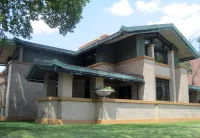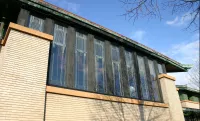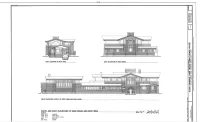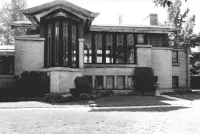Share what you know,
and discover more.
Share what you know,
and discover more.
May 19, 2012

-

- Charmaine Bantugan
Susan Lawrence Dana House
The Dana–Thomas House (also known as the Susan Lawrence Dana House and Dana House) is a home in Prairie School style designed by architect Frank Lloyd Wright. Built 1902–04 for patron Susan Lawrence Dana, it is located along East Lawrence Avenue in Springfield, Illinois. The home reflects the mutual affection of the patron and the architect for organic architecture, the relatively flat landscape of the U.S. state of Illinois, and the Japanese aesthetic as expressed in Japanese prints. Susan Lawrence Dana Susan Lawrence Dana (1862–1946) was an independent-minded woman and heiress to a substantial fortune, including silver mines in the Rocky Mountains. Widowed in 1900, Dana enjoyed complete control over her household and fortune. Eager to express her personality and become a leading philanthropic figure in Springfield, Dana decided to completely remodel her family's Italianate mansion located in the state capital's fashionable "Aristocracy Hill" neighborhood. Dana House Dana's search for an architect to match her aspirations ended when she was introduced in 1902 to Frank Lloyd Wright, the rising leader of the new Prairie School movement of "organic architecture" which stressed congruence between the interior of a building and its surroundings. The Dana commission to plan the remodeling of the Lawrences' Italianate mansion was the largest Wright had received. Recognizing a kindred spirit in Mrs. Dana, he expanded the boundaries of his contract to design and build what was, in effect, an entirely new house showcasing his approach to the Prairie Style aesthetic. The new home reflected the flamboyant personalities of the patron and the architect, particularly their love of Japanese prints and drawings. The structure was designed for both display and entertainment. An arched doorway admitted guests into a series of expanding spaces, transitioning from vestibule to the reception hall. The concept of "expanding space" was repeated throughout the house, with windows placed to continually draw the attention of someone within toward an awareness of the outside. Wright designed approximately 450 art glass windows, skylights, door panels, sconces, and light fixtures for the house, most of which survive. Much of the art glass, and the mural by George Mann Niedecken surmounting the dining room interior, centered on a sumac motif. A substantial west wing leads visitors through an interior Torii gate into two of the largest rooms in the house. The upper-level gallery was used for musical entertaining, and the ground-level library contains special easels, part of more than 100 pieces of free-standing Wright-designed white oak furniture in the house, created for Dana to display selections from her collection of Japanese prints,. Dana lived in the home from 1904 until about 1928. Once a successful hostess and leader of Springfield's social scene, she became increasingly reclusive over time and turned her attention to spiritualism and the occult. Suffering from increasing financial constraints in her later years, she closed the main house around 1928 and moved to a small cottage on the grounds. As Dana struggled with age-related dementia in the 1940s, her home and its contents were sold. Dana-Thomas House Charles C. Thomas, a successful medical publisher, was the second owner and custodian of the home from 1944 to his death in 1969. A view of the building was featured on the title pages of some of his publications. His wife Nanette maintained in that role until her passing in 1975. The couple are credited with maintaining the house's original furnishings and design, and their estate with selling the home and its furnishings as a unit to the state of Illinois in 1981 for $1.0 million, significantly less than could have been earned had the household been broken up. The home today The home became a state historic site under the Illinois Historic Preservation Agency (IHPA). The IHPA led a restoration effort in 1987–1990 that restored the structure and its contents to its appearance in 1910. It is believed to contain one of the most intact Frank Lloyd Wright designed interiors in the United States. Restoration plans and documents are held by the Ryerson & Burnham Libraries at the Art Institute of Chicago. The house was featured in Bob Vila's A&E Network 1996 production, Guide to Historic Homes of America.In celebration of the 2018 Illinois Bicentennial, the Dana Thomas House was selected as one of the Illinois 200 Great Places by the American Institute of Architects Illinois component (AIA Illinois). As part of a program of budget cuts, the state of Illinois temporarily closed the Dana–Thomas House to the public from December 1, 2008, until April 23, 2009. The Dana–Thomas House again closed for 11 months in 2011 for renovations to interior and exterior finish as well as mechanical and security systems.
Susan Lawrence Dana House
The Dana–Thomas House (also known as the Susan Lawrence Dana House and Dana House) is a home in Prairie School style designed by architect Frank Lloyd Wright. Built 1902–04 for patron Susan Lawrence Dana, it is located along East Lawrence Avenue in Springfield, Illinois. The home reflects the mutual affection of the patron and the architect for organic architecture, the relatively flat landscape of the U.S. state of Illinois, and the Japanese aesthetic as expressed in Japanese prints. Susan Lawrence Dana Susan Lawrence Dana (1862–1946) was an independent-minded woman and heiress to a substantial fortune, including silver mines in the Rocky Mountains. Widowed in 1900, Dana enjoyed complete control over her household and fortune. Eager to express her personality and become a leading philanthropic figure in Springfield, Dana decided to completely remodel her family's Italianate mansion located in the state capital's fashionable "Aristocracy Hill" neighborhood. Dana House Dana's search for an architect to match her aspirations ended when she was introduced in 1902 to Frank Lloyd Wright, the rising leader of the new Prairie School movement of "organic architecture" which stressed congruence between the interior of a building and its surroundings. The Dana commission to plan the remodeling of the Lawrences' Italianate mansion was the largest Wright had received. Recognizing a kindred spirit in Mrs. Dana, he expanded the boundaries of his contract to design and build what was, in effect, an entirely new house showcasing his approach to the Prairie Style aesthetic. The new home reflected the flamboyant personalities of the patron and the architect, particularly their love of Japanese prints and drawings. The structure was designed for both display and entertainment. An arched doorway admitted guests into a series of expanding spaces, transitioning from vestibule to the reception hall. The concept of "expanding space" was repeated throughout the house, with windows placed to continually draw the attention of someone within toward an awareness of the outside. Wright designed approximately 450 art glass windows, skylights, door panels, sconces, and light fixtures for the house, most of which survive. Much of the art glass, and the mural by George Mann Niedecken surmounting the dining room interior, centered on a sumac motif. A substantial west wing leads visitors through an interior Torii gate into two of the largest rooms in the house. The upper-level gallery was used for musical entertaining, and the ground-level library contains special easels, part of more than 100 pieces of free-standing Wright-designed white oak furniture in the house, created for Dana to display selections from her collection of Japanese prints,. Dana lived in the home from 1904 until about 1928. Once a successful hostess and leader of Springfield's social scene, she became increasingly reclusive over time and turned her attention to spiritualism and the occult. Suffering from increasing financial constraints in her later years, she closed the main house around 1928 and moved to a small cottage on the grounds. As Dana struggled with age-related dementia in the 1940s, her home and its contents were sold. Dana-Thomas House Charles C. Thomas, a successful medical publisher, was the second owner and custodian of the home from 1944 to his death in 1969. A view of the building was featured on the title pages of some of his publications. His wife Nanette maintained in that role until her passing in 1975. The couple are credited with maintaining the house's original furnishings and design, and their estate with selling the home and its furnishings as a unit to the state of Illinois in 1981 for $1.0 million, significantly less than could have been earned had the household been broken up. The home today The home became a state historic site under the Illinois Historic Preservation Agency (IHPA). The IHPA led a restoration effort in 1987–1990 that restored the structure and its contents to its appearance in 1910. It is believed to contain one of the most intact Frank Lloyd Wright designed interiors in the United States. Restoration plans and documents are held by the Ryerson & Burnham Libraries at the Art Institute of Chicago. The house was featured in Bob Vila's A&E Network 1996 production, Guide to Historic Homes of America.In celebration of the 2018 Illinois Bicentennial, the Dana Thomas House was selected as one of the Illinois 200 Great Places by the American Institute of Architects Illinois component (AIA Illinois). As part of a program of budget cuts, the state of Illinois temporarily closed the Dana–Thomas House to the public from December 1, 2008, until April 23, 2009. The Dana–Thomas House again closed for 11 months in 2011 for renovations to interior and exterior finish as well as mechanical and security systems.
May 19, 2012
Susan Lawrence Dana House
The Dana–Thomas House (also known as the Susan Lawrence Dana House and Dana House) is a home in Prairie School style designed by architect Frank Lloyd Wright. Built 1902–04 for patron Susan Lawrence Dana, it is located along East Lawrence Avenue in Springfield, Illinois. The home reflects the mutual affection of the patron and the architect for organic architecture, the relatively flat landscape of the U.S. state of Illinois, and the Japanese aesthetic as expressed in Japanese prints.Susan Lawrence Dana
Susan Lawrence Dana (1862–1946) was an independent-minded woman and heiress to a substantial fortune, including silver mines in the Rocky Mountains. Widowed in 1900, Dana enjoyed complete control over her household and fortune. Eager to express her personality and become a leading philanthropic figure in Springfield, Dana decided to completely remodel her family's Italianate mansion located in the state capital's fashionable "Aristocracy Hill" neighborhood.
Dana House
Dana's search for an architect to match her aspirations ended when she was introduced in 1902 to Frank Lloyd Wright, the rising leader of the new Prairie School movement of "organic architecture" which stressed congruence between the interior of a building and its surroundings.
The Dana commission to plan the remodeling of the Lawrences' Italianate mansion was the largest Wright had received. Recognizing a kindred spirit in Mrs. Dana, he expanded the boundaries of his contract to design and build what was, in effect, an entirely new house showcasing his approach to the Prairie Style aesthetic.
The new home reflected the flamboyant personalities of the patron and the architect, particularly their love of Japanese prints and drawings. The structure was designed for both display and entertainment. An arched doorway admitted guests into a series of expanding spaces, transitioning from vestibule to the reception hall.
The concept of "expanding space" was repeated throughout the house, with windows placed to continually draw the attention of someone within toward an awareness of the outside. Wright designed approximately 450 art glass windows, skylights, door panels, sconces, and light fixtures for the house, most of which survive. Much of the art glass, and the mural by George Mann Niedecken surmounting the dining room interior, centered on a sumac motif.
A substantial west wing leads visitors through an interior Torii gate into two of the largest rooms in the house. The upper-level gallery was used for musical entertaining, and the ground-level library contains special easels, part of more than 100 pieces of free-standing Wright-designed white oak furniture in the house, created for Dana to display selections from her collection of Japanese prints,.
Dana lived in the home from 1904 until about 1928. Once a successful hostess and leader of Springfield's social scene, she became increasingly reclusive over time and turned her attention to spiritualism and the occult. Suffering from increasing financial constraints in her later years, she closed the main house around 1928 and moved to a small cottage on the grounds. As Dana struggled with age-related dementia in the 1940s, her home and its contents were sold.
Dana-Thomas House
Charles C. Thomas, a successful medical publisher, was the second owner and custodian of the home from 1944 to his death in 1969. A view of the building was featured on the title pages of some of his publications. His wife Nanette maintained in that role until her passing in 1975. The couple are credited with maintaining the house's original furnishings and design, and their estate with selling the home and its furnishings as a unit to the state of Illinois in 1981 for $1.0 million, significantly less than could have been earned had the household been broken up.
The home today
The home became a state historic site under the Illinois Historic Preservation Agency (IHPA). The IHPA led a restoration effort in 1987–1990 that restored the structure and its contents to its appearance in 1910. It is believed to contain one of the most intact Frank Lloyd Wright designed interiors in the United States. Restoration plans and documents are held by the Ryerson & Burnham Libraries at the Art Institute of Chicago.
The house was featured in Bob Vila's A&E Network 1996 production, Guide to Historic Homes of America.In celebration of the 2018 Illinois Bicentennial, the Dana Thomas House was selected as one of the Illinois 200 Great Places by the American Institute of Architects Illinois component (AIA Illinois).
As part of a program of budget cuts, the state of Illinois temporarily closed the Dana–Thomas House to the public from December 1, 2008, until April 23, 2009. The Dana–Thomas House again closed for 11 months in 2011 for renovations to interior and exterior finish as well as mechanical and security systems.
Posted Date
Aug 23, 2022
Historical Record Date
May 19, 2012
Source Name
Wikipedia
Source Website
Delete Story
Are you sure you want to delete this story?
Jun 30, 1974
Jun 30, 1974

-

- Charmaine Bantugan
National Register of Historic Places - Susan Lawrence Dana House
Statement of Significance: The Dana House is one of Wright's masterworks of his early period—he lavished upon it all of his creative skill—and it still retains a great deal of original glass, tile and furniture, all custom made to the architect's specifications. It was the showplace of Springfield in its day and remains one of the most important examples of early 20th century architecture. Paul Sprague writes: "One of Frank Lloyd Wright's grandest houses from his Oak Park period was designed in 1902 for the Springfield socilite Susan Lawrence Dana. Of the many rumors about her alleged eccentric personality only one, necessary to understand the most unusual part of the house, need be cited. It is said that her father, Rheuna Lawrence, willed to her the family home in Springfield but only on the condition that she retain it in any building schemes she might entertain. When the commission came to Wright his solution to this curious problem was to build the new house around the old, demolishing the latter as he went while preserving from the old house a single room in its original state. Most writers on the house do not seem to know that the house was designed in 1902, and the library, three years later in 1905. The house originally terminated on the west side of the Lawrence Avenue front probably as an open porch. The library, when added, was connected to it by extending and enclosing the porch. Grant Manson in his Frank Lloyd Wright to 1910 has the following to say about the family: "The Lawrences had been pioneers in the settlement of central Illinois, but by the twentieth century they were off the land, living in affluence at the State capital. Only 'Mother Lawrence', kindly remembered in 'An Autobiography1 for her home—made blackberry jam and salt-risen bread, retained the simple tastes of pioneer days. Her daughter, Susan Dana, was a woman of ambition and far wider outlook. She came to Wright to place the commission for a new house at Springfield which would be not merely a residence but a family memorial and a setting for the suitable discharge of her obligations as a social leader of the community."
National Register of Historic Places - Susan Lawrence Dana House
Statement of Significance: The Dana House is one of Wright's masterworks of his early period—he lavished upon it all of his creative skill—and it still retains a great deal of original glass, tile and furniture, all custom made to the architect's specifications. It was the showplace of Springfield in its day and remains one of the most important examples of early 20th century architecture. Paul Sprague writes: "One of Frank Lloyd Wright's grandest houses from his Oak Park period was designed in 1902 for the Springfield socilite Susan Lawrence Dana. Of the many rumors about her alleged eccentric personality only one, necessary to understand the most unusual part of the house, need be cited. It is said that her father, Rheuna Lawrence, willed to her the family home in Springfield but only on the condition that she retain it in any building schemes she might entertain. When the commission came to Wright his solution to this curious problem was to build the new house around the old, demolishing the latter as he went while preserving from the old house a single room in its original state. Most writers on the house do not seem to know that the house was designed in 1902, and the library, three years later in 1905. The house originally terminated on the west side of the Lawrence Avenue front probably as an open porch. The library, when added, was connected to it by extending and enclosing the porch. Grant Manson in his Frank Lloyd Wright to 1910 has the following to say about the family: "The Lawrences had been pioneers in the settlement of central Illinois, but by the twentieth century they were off the land, living in affluence at the State capital. Only 'Mother Lawrence', kindly remembered in 'An Autobiography1 for her home—made blackberry jam and salt-risen bread, retained the simple tastes of pioneer days. Her daughter, Susan Dana, was a woman of ambition and far wider outlook. She came to Wright to place the commission for a new house at Springfield which would be not merely a residence but a family memorial and a setting for the suitable discharge of her obligations as a social leader of the community."
National Register of Historic Places - Susan Lawrence Dana House
Statement of Significance:The Dana House is one of Wright's masterworks of his early period—he lavished upon it all of his creative skill—and it still retains a great deal of original glass, tile and furniture, all custom made to the architect's specifications. It was the showplace of Springfield in its day and remains one of the most important examples of early 20th century architecture.
Paul Sprague writes: "One of Frank Lloyd Wright's grandest houses from his Oak Park period was designed in 1902 for the Springfield socilite Susan Lawrence Dana. Of the many rumors about her alleged eccentric personality only one, necessary to understand the most unusual part of the house, need be cited. It is said that her father, Rheuna Lawrence, willed to her the family home in Springfield but only on the condition that she retain it in any building schemes she might entertain. When the commission came to Wright his solution to this curious problem was to build the new house around the old, demolishing the latter as he went while preserving from the old house a single room in its original state.
Most writers on the house do not seem to know that the house was designed in 1902, and the library, three years later in 1905. The house originally terminated on the west side of the Lawrence Avenue front probably as an open porch. The library, when added, was connected to it by extending and enclosing the porch.
Grant Manson in his Frank Lloyd Wright to 1910 has the following to say about the family: "The Lawrences had been pioneers in the settlement of central Illinois, but by the twentieth century they were off the land, living in affluence at the State capital. Only 'Mother Lawrence', kindly remembered in 'An Autobiography1 for her home—made blackberry jam and salt-risen bread, retained the simple tastes of pioneer days. Her daughter, Susan Dana, was a woman of ambition and far wider outlook. She came to Wright to place the commission for a new house at Springfield which would be not merely a residence but a family memorial and a setting for the suitable discharge of her obligations as a social leader of the community."
Posted Date
Aug 23, 2022
Historical Record Date
Jun 30, 1974
Source Name
National Register of Historic Places
Source Website
Delete Story
Are you sure you want to delete this story?















